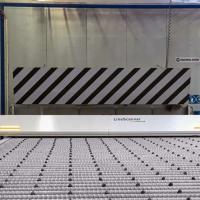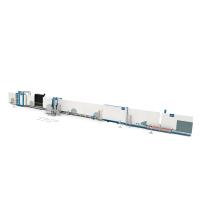First presented at GPD 2019
This type of production has a strong mass customisation aspect, that is the production of individual pieces with a high degree of automation.
Due to time constraints we’ll mainly focus on order processing, but our intent is that all data is entered only once and is ultimately available on your machines, and for all other functions supporting your manufacturing processes. If we want to achieve a high degree of automation, then order processing and production are closely tied together.
State of the Art
The vast majority of current standard software solutions is based on a classical client server architecture. The current solutions have very little interoperability between them. This makes it very cumbersome not only when it comes to external ordering of components, but often on the automation side as well.
In the glass industry products are tailored to customer specifications. For example, insulation glass units (IGUs), or showers in customized sizes and shapes. There are already a lot of manufacturers that can produce that with a high degree of automation. There are also software solutions that facilitate the specification of such products and can largely automate quoting as well.
Many software solutions support automated processing too. Starting with the optimisation of the layout of the pieces on stock sheets for waste minimisation, followed by cutting code generation for glass cutters. Then we have the data generation for machining on equipment for further processing such as drilling or waterjet-cutting for the production of cut-outs.
This can be extended into controlling entire factories, beginning with the automatic loading The Future of Software in Glass Processing of stock sheets onto cutting tables, over the caching of individual pieces in sorting arrays or harp racks and the control of insulating glass lines for the assembly of IGUs.
Interfaces with suppliers within the glass industry exist in part already as well, for example to purchase specific glass pieces from an external manufacturer, or for the specification of Georgian bars when they are supplied externally.
The Problems
Let’s look at a small business, customer of a larger glass processor, say a carpenter who amongst other things builds windows with wooden frames, or a glazier specializing in the installation of purchased products and the replacement of broken windows. These businesses generally have no electronic interface to their suppliers.
This often results in a sketch being sent, for example by email of a pdf or jpeg to the supplying company. There, this order is entered and a properly scaled drawing is sent back with the order confirmation. If the customer can’t find his sketch in a hurry and does not verify, then there is a risk of something wrong being delivered.

In the case of a larger customer, say a window manufacturer or an installer of curtain walls, a single factory might not be able to produce all the parts this customer needs. Let’s say you are producing insulation glass units and you need some laminate or fire protection glass that you can’t cut yourself.
Or it is just one of those odd shaped pieces with the strange mitres.
Or you need some Georgian bars that have an irregular, non-rectangular pattern.

Or your customer orders with hundreds of other pieces that odd one built from curved and bent glass.
Our Vision
Let’s imagine you have a solution in the cloud where your customers can enter their orders and get a quote immediately. Most likely your window manufacturing customer can’t enter non-Rectangular Georgian bar patterns in his software either. Or your curtain wall installer can’t order curved glass electronically. But imagine you offer a cloud interface where they can enter that, although you might not produce the items or some components yourself.
Thus, we have to include not only your customers into your cloud solution but your suppliers as well. If your customers are in turn integrated to some degree with their customers as well, then in future we could achieve an automated way of updating measurements or delivery times along the supply chain, for example from the building site over the window manufacturer to the producer of the IGUs and further to his suppliers.
Ideally, you offer smaller customers an interface in the cloud, where they can enter their order and get a quote immediately:

Where safety risks are small, glass companies also supply to unqualified end customers. These are for example mirrors, or toughened glass, always with polished edges to make sure nobody can hurt themselves. You could use the same cloud interface, but offering the public only a restricted range of products. Automatic price determination then becomes fairly simple.
Larger customers already order electronically, for example window manufacturers as mentioned above. This works for the bulk of orders, but the interfaces should be unified and extended in such a way that even the most complex products can be specified within them and that they are further expandable. Smaller manufacturers, who can’t or do not want to compete with every technology, should still be able to work with a sufficient subset of such a specification. Ideally, they then send their orders directly to your server in the cloud, where they could get quotes automatically as well.
Picture 4 gives an idea of the architecture we envision. Most of your IT infrastructure is in the cloud and so is your partners’. A partner can be a customer or a supplier. In many cases they are both, a supplier in some instances and a customer in others.

The graphic illustrates the idea of how as a manufacturer (dark green) you will be connected in the cloud with customers and suppliers (light green). When your customer goes through his ordering process, his system will include the costs of your products, either by linking into your own quoting system (if you allow him to do so) or by mapping your price structure on his system. Your system will do the same with your suppliers and so forth.
Of course, your production then is firmly on the ground. The horizontal (purple) path illustrates your investment and maintenance cycle, including upgrades and modernisations of plant and equipment.
The picture does not show the production processes themselves, but possible software products supporting it. Of course, many of those software products could run locally or in the cloud. We will discuss possible architectures and trade-offs later.
Cloud solutions have many advantages. They are way more reliable and hacker proof than you can ever be with your own server, and you never have to think about back up again.
You can interact with suppliers and customers directly in the cloud. If your supplier uses the same software or there is a standard interface, then you can automatically get quotes from him and so can your customers from you. Maybe one of your suppliers contributes a solution for say curved glass to the cloud

And another for special Georgian bars

You can use that in just the cases you need it and simply pay per use. And you can redirect your customers to those sites without them necessarily becoming aware that they no longer are running your part of the cloud app.
Complex customer specific products are often developed and specified jointly in cooperation between end customer, the main contractor and his suppliers. This will in the future take place transparently on a common development platform in the cloud. In the glass industry these are complex major projects. Whilst the daily business is automated to a high degree, in complex projects there will be a planning phase where specifications are worked out, usually by a team of architects and engineers on the customers’ side and application specialists on the suppliers’ side. However, once all is worked out, ideally the same degree of automated processing should apply.
Architectures
Of course, all you need for a cloud solution is some sort of server in the cloud and some devices with a browser to run it. However, I think for now you would feel a little bit uncomfortable if the computer at your cutting table or even the break display is just a browser hooked up to the cloud. Thus, we suggest several possible architectures that could suit you, depending on the size and type of factory you run.
The luxury solution would be, that you run an internal server as well, with the same order processing software as you have in the cloud and the two databases replicating each other. This has the advantage that even if you lose internet, your customers as well as you internally can still process orders. If internet comes back, they will automatically update each other and eventually be consistent again (Picture 7).

In that scenario your internal server extends into a production server to drive your production as well, and if your software provider is consistent in their approach, then they provide that as an internal cloud solution too, at least as far as user interfaces are concerned and as is possible in connection with the machines.
As a smaller manufacturer you can’t afford to run your own server. Or you might figure in five years’ time that servers in the cloud are more reliable than you can ever run internally. Then you rely on your provider to do the replication in the cloud, only running a small production server to support your production even if your internet connection is down (Picture 8).

And if (depending on your situation) in maybe ten years’ time you find that your internet is only down if power is down, then you might even move the production server to the cloud (Picture 9).

Supporting Technologies
Here I just want to point out two new, up and coming technologies that I think will soon be ready to be used to support manufacturing businesses in general and glass processors in particular.
Block Chain Technology
If everything is so complexly connected and interwoven, then it needs the right contracts, and compliance by all participants has to be monitored. Block Chain technology, initially developed for Bit Coin, can help. With every order that is electronically generated, a contract is created. This contract is now generated electronically and runs with the order. This electronic contract is extended in the Block Chain standard with every event concerning the execution of the contract (order, confirmation, (partial) delivery, acceptance, invoice, reminder, payment, etc.). Thus, during the whole process and right to the end, everything can be looked up without having to search for documents, and all this with extremely high security
Again, there will have to be standards, to make sure all stakeholders can participate. This is going to take a while. I do not think that is going to happen within a year, but a lot can happen by 2025. In the meantime, we will have to live with some trust and the old forms of contracts.
Internet of Things
As with other industries, machines in the glass industry will increasingly be equipped with electronics that make use of the Internet of Things (IoT). Engineers will install more and more sensors to monitor all possible states of the machines and their components. This will allow them to do preventative maintenance of the machines, thus increasing the reliability of their machines.
If all your and your suppliers’ products were electronically equipped, so that they at least would know what they are, then they could easily be tracked along the supply chain and through production. The system would always know for example when a product leaves the factory, on which rack it is, on which truck, and where it has been unloaded - always assuming the corresponding electronics travels with the truck. Of course, in this way one could also keep track of the delivery racks too.
Our Proposition
Most industries were very successful in introducing norms and standards. For example, in manufacturing of machines and their parts, not only are there norms for standard parts like screws and bolts, but there are standards for data describing and producing machine parts as well. In our industry, every window or glass processing software provider has their own standards. At best we use the .dxf format (adopted from the machine industry!) to digitally exchange the shape of a piece. The machine manufactures all have their own interface standards as well.
What we are proposing now is that we introduce data exchange standards, for a start at least for the glass industry but it would be great if the window software manufacturers would come to the party too.
The same holds for the machine manufacturers, where I wish there was a basic standard for each type of machine. Too often I was faced with the fact that to improve processes I wanted a particular machine to do something that the machinery could do, but the very sophisticated software on the machine came with no interface for that basic operation.
I would be happy to help set up and contribute to some sort of a standards body. If you are interested, please contact me anytime.


























